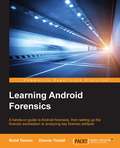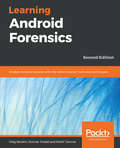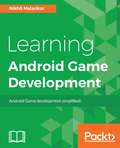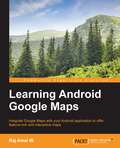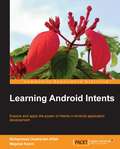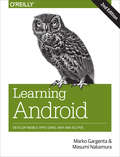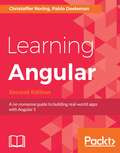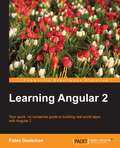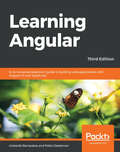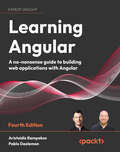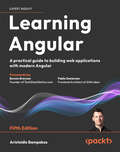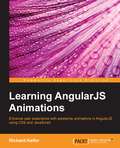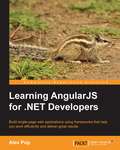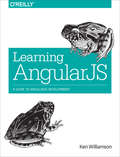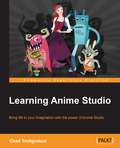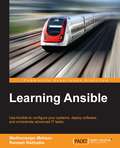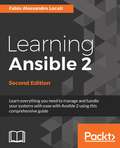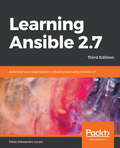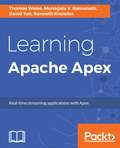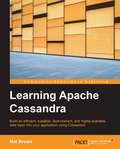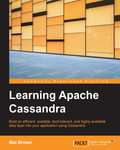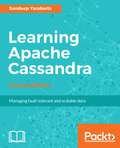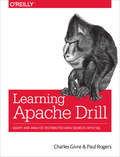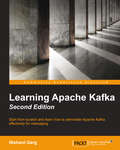- Table View
- List View
Learning Android Forensics
by Rohit Tamma Donnie TindallIf you are a forensic analyst or an information security professional wanting to develop your knowledge of Android forensics, then this is the book for you. Some basic knowledge of the Android mobile platform is expected.
Learning Android Forensics - Second Edition: Analyze Android devices with the latest forensic tools and techniques, 2nd Edition
by Rohit Tamma Donnie Tindall Oleg SkulkinIf you are a forensic analyst or an information security professional wanting to develop your knowledge of Android forensics, then this is the book for you. Some basic knowledge of the Android mobile platform is expected.
Learning Android Game Development
by Nikhil MalankarLearn the art of making Android games and turn your game development dreams into reality About This Book • Leverage the latest features of Android N to create real-world 2D games • Architect a 2D game from scratch and level up your Android game development skill • Transition from developing simple 2D games to 3D games using basic Java code Who This Book Is For If you are a mobile developer who has basic Java programming knowledge, then this book is ideal for you. Previous Android development experience is not needed; however, basic mobile development knowledge is essential. What You Will Learn • Understand the nuts and bolts of developing highly interactive and interesting games for Android N • Link the interface to the code used in games through simple methods • Interact with the images on the screen and also learn to animate them • Set and save the game state and save high scores, hit points, and so on for your games • Get a grasp of various collision techniques and implement the bounding box technique • Convert your 2D games to 3D games using Android N • Get an understanding of the process of UI creation using Android Studio In Detail In this book, we'll start with installing Android studio and its components, and setting it up ready for Android N. We teach you how to take inputs from users, create images and interact with them, and work with sprites to create animations. You'll then explore the various collision detection methods and use sprites to create an explosion. Moving on, you'll go through the process of UI creation and see how to create buttons as well as display the score and other parameters on screen. By the end of the book, you will have a working example and an understanding of a 2D platform game like Super Mario and know how to convert your 2D games to 3D games. Style and approach This easy-to-understand guide follows a step-by-step approach to building games, and contains plenty of graphical examples for you to follow and grasp quickly, giving you the chance to implement the concepts practically.
Learning Android Google Maps
by Raj Amal W.Integrate Google Maps with your Android application to offer feature-rich and interactive maps About This Book * Set up the development environment and obtain the Google API key to create your first map application * Create a cutting edge Google maps application by implementing all the concepts learned * A step-by-step tutorial guide that is full of pragmatic examples Who This Book Is For If you are an Android developer and want to integrate maps into your application, then this book is definitely for you. This book is intended for novice Android application developers who would like to get up and running with map rich applications using Google Maps. Some basic development experience would be helpful but it's not a mandate. What You Will Learn * Get to know about the basic development environment setup needed to create a successful map application * Generate an SHA1 fingerprint, obtain an API key, and create a basic map application * Detect different types of maps and implement them in your application * Add information to your map such as markers, overlays, information windows, and shapes * Explore the interaction with maps and work with gestures * Change the different camera views in your map application * Work with real-time GPS location data and implementing it in your application * Apply Street View and integrate the StreetViewPanoroma fragment to your application * Employ the native Google maps application to solve some of the tasks using intents * Create a cutting edge Google maps application by implementing all the concepts learned In Detail This book helps you to overcome the most common problems faced by users and helps you create a successful map application without any hassle. The book starts with a brief description of how to set up an environment and obtain an API key to create your map application. This book will teach you about adding markers, overlays, and information windows to the map in detail. You will then dive deep into customizing various types of maps and working with location data and Google Street view. By the end of this book, you will be able to create succinct map applications in Android using Google maps efficiently. Style and approach The book is tailored for the reader with a fundamental approach to Android Google Maps providing a step-by-step introduction to Android Google Maps. It focuses on simple, easy-to-understand examples that are pragmatic and serve as useful basis for real-world applications. Different topics are approached in a bottom-up fashion, gradually going from the simplest foundations to the most advanced features.
Learning Android Intents
by Muhammad Usama Aftab Wajahat KarimThe book will take an easy-to-follow and engaging tutorial approach, providing a practical and comprehensive way to learn Android intents. If you are a novice or an intermediate Android Developer who wants to expand their knowledge of Android Intents, this book is ideal for you. Readers are expected to have basic understanding of Android development, how to use different IDEs, and how to develop applications using Android APIs.
Learning Android: Develop Mobile Apps Using Java and Eclipse
by Marko Gargenta Masumi NakamuraWant to build apps for Android devices? This book is the perfect way to master the fundamentals. Written by experts who have taught this mobile platform to hundreds of developers in large organizations and startups alike, this gentle introduction shows experienced object-oriented programmers how to use Android’s basic building blocks to create user interfaces, store data, connect to the network, and more.Throughout the book, you’ll build a Twitter-like application, adding new features with each chapter. You’ll also create your own toolbox of code patterns to help you program any type of Android application with ease.Become familiar with the Android platform and how it fits into the mobile ecosystemDive into the Android stack, including its application framework and the APK application packageLearn Android’s building blocks: Activities, Intents, Services, Content Providers, and Broadcast ReceiversCreate basic Android user interfaces and organize UI elements in Views and LayoutsBuild a service that uses a background process to update data in your application
Learning Angular - Second Edition
by Pablo Deeleman Christoffer NoringBuild modern SPAs by learning the latest and powerful features of Angular 5 and TypeScript 2.x About This Book • The best overview of Angular 5 on the market, this guide gathers together everything there is to know about Angular 5 and groups it into intuitive sections. • Learn to build, grow and test powerful and scalable mobile and desktop web applications with Angular • Explore the latest features of Angular 5 and TypeScript 2.4 by building a complete responsive application from scratch. • Deliver seamless web navigation experiences with application routing and state handling common features with ease • The author has done all the hard work of fitting everything Angular 5 means for developers, making this book the quickest way to learn Angular 5 from scratch. Who This Book Is For This book is for web developers who want to build the next generation of state-of-the-art mobile and desktop web applications with Angular. This book does not require you to have prior exposure to either Angular 1.x, 2 or 4, although comprehensive knowledge of JavaScript is assumed. What You Will Learn • Set up the workspace and the project using webpack and Angular-Cli • Explore the features of TypeScript and organize the code in ES6 modules • Work with HTTP and Data Services and understand how data can flow in the app • Create multiple views and learn how to navigate between them • Make the app beautiful by adding Material Design • Implement two different types of form handling and its validation • Add animation to some standard events such as route change, initialization, data load, and so on • Discover how to bulletproof your applications by introducing smart unit testing techniques and debugging tools In Detail The latest version of Angular comes with a lot of new features that help you to make your applications smaller and faster. This book will show you how to set up an Angular project, and you'll build Angular components right from the beginning. Moving on, you'll explore and work with the components to build your app. Next, you'll find out more about TypeScript and see how to use it to build apps in the best way possible. You'll then be introduced to the building blocks - Properties, Events, Directives, and Pipes - and how it can be used to implement and enhance the components. Additionally, you'll be using Angular components to organize your components in a scalable way. Then you'll understand how to get data in your app and add navigation to it. Furthermore, you'll deep dive and work with Forms, Authentication, and see how Material design will help you make your app beautiful in just a few short lines of code. Lastly, you'll see how to use animating components with Angular, and test and debug the app. All in all, the overall mission is to give you a great start when developing apps using Angular and TypeScript. Style and approach This book tells you everything there is to know about getting well-acquainted with Angular without bogging you down. Everything is neatly laid out under clear headings for quick consultation, giving you the information required to understand a concept immediately. You'll also get full coverage of the TypeScript syntax required to follow the examples included.
Learning Angular 2
by Pablo DeelemanYour quick, no-nonsense guide to building real-world apps with Angular 2 About This Book * The first and best overview of Angular 2 on the market--this guide gathers together everything there is to know about Angular 2 and groups it into intuitive sections. * This book is your detailed map of every feature and its use cases. * The author has done all the hard work of fitting everything Angular 2 means for developers together for you, making this book the quickest way to learn Angular 2 from scratch. Who This Book Is For This book is targeted at web developers who want to build the next generation of state-of-the-art mobile and desktop web applications with Angular 2. This book does not require you to have prior exposure to either Angular 1.x or 2, although comprehensive knowledge of JavaScript is assumed. It's great for newcomers to Angular who learn best through clear explanations and definitions of concepts. What You Will Learn * Set up your working environment in order to have all the tools you need to start building Angular 2 components with minimum effort * Get up to speed with TypeScript, a powerful typed superset of JavaScript that compiles to plain JavaScript * Take full control of how your data is rendered and updated upon data changes * Build powerful web applications based on structured component hierarchies that emit and listen to events and data changes throughout the elements tree * Explore how to consume external APIs and data services and allow data editing by harnessing the power of web forms made with Angular 2 * Deliver seamless web navigation experiences with application routing and state handling common features with ease * Discover how to bulletproof your applications by introducing smart unit testing techniques and debugging tools In Detail Angular 2 was conceived as a complete rewrite in order to fulfill the expectations of modern developers who demand blazing fast performance and responsiveness from their web applications. This book will help you learn the basics of how to design and build Angular 2 components right from the beginning, providing full coverage of the TypeScript syntax required to follow the examples included. From that point on, we will build upon our first components, interconnect them, and give shape to larger web applications. We will then move to implementing routing in Angular 2, analyzing how to handle application states, and navigating from one component to another in depth. After this, the book features full coverage of web forms and user input validation, later leveraging all of this information to go through the basics of implementing user authentication in Angular 2 and providing a bird's eye view of the different strategies at hand to secure pages and areas of your website. Animating components and DOM elements with Angular 2 is also covered in this book. The final part of this book provides broad insights into how to unit test components and other modules such as services, directives, routes or pipes. Style and approach This book covers everything there is to know about getting well-acquainted with Angular without bogging you down. Everything is neatly laid out under clear headings for quick consultation, offering you the information required to understand a concept immediately, with short relevant examples of each feature.
Learning Angular for .NET Developers
by Rajesh GunasundaramBuild efficient web apps and deliver great results by integrating Angular and the .NET framework About This Book • Become a more productive developer and learn to use frameworks that implement good development practices • Achieve advanced autocompletion, navigation, and refactoring in Angular using Typescript • Follow a gradual introduction to the concepts with a lot of examples and explore the evolution of a production-ready application Who This Book Is For If you are a .NET developer who now wants to efficiently build single-page applications using the new features that Angular 4 has to offer, then this book is for you. Familiarity of HTML, CSS, and JavaScript is assumed to get the most from this book. What You Will Learn • Create a standalone Angular application to prototype user interfaces • Validate complex forms with Angular version 4 and use Bootstrap to style them • Build RESTful web services that work well with single-page applications • Use Gulp and Bower in Visual Studio to run tasks and manage JavaScript packages • Implement automatic validation for web service requests to reduce your boilerplate code • Use web services with Angular version 4 to offload and secure your application logic • Test your Angular version 4 and web service code to improve the quality of your software deliverables In Detail Are you are looking for a better, more efficient, and more powerful way of building front-end web applications? Well, look no further, you have come to the right place! This book comprehensively integrates Angular version 4 into your tool belt, then runs you through all the new options you now have on hand for your web apps without bogging you down. The frameworks, tools, and libraries mentioned here will make your work productive and minimize the friction usually associated with building server-side web applications. Starting off with building blocks of Angular version 4, we gradually move into integrating TypeScript and ES6. You will get confident in building single page applications and using Angular for prototyping components. You will then move on to building web services and full-stack web application using ASP.NET WebAPI. Finally, you will learn the development process focused on rapid delivery and testability for all application layers. Style and approach This book covers everything there is to know about getting well-acquainted with Angular 4 and .NET without bogging you down. Everything is neatly laid out under clear headings for quick consultation, offering you the information required to understand a concept immediately, with short, relevant examples of each feature.
Learning Angular: A no-nonsense beginner's guide to building web applications with Angular 10 and TypeScript, 3rd Edition
by Aristeidis Bampakos Pablo DeelemanUncover Angular's potential for creating enterprise web applications—from setting up the environment to deployment—with the help of expert guidance, step-by-step explanations, and hands-on exercisesKey FeaturesLearn the fundamentals of Angular to build web applications using TypeScriptExplore the basics of Angular development, from components and templates to forms and servicesDiscover best practices for building, packaging, and testing Angular applicationsBook DescriptionAngular, loved by millions of web developers around the world, continues to be one of the top JavaScript frameworks thanks to its regular updates and new features that enable fast, cross-platform, and secure frontend web development. With Angular, you can achieve high performance using the latest web techniques and extensive integration with web tools and integrated development environments (IDEs).Updated to Angular 10, this third edition of the Learning Angular book covers new features and modern web development practices to address the current frontend web development landscape. If you are new to Angular, this book will give you a comprehensive introduction to help you get you up and running in no time. You'll learn how to develop apps by harnessing the power of the Angular command-line interface (CLI), write unit tests, style your apps by following the Material Design guidelines, and finally deploy them to a hosting provider. The book is especially useful for beginners to get to grips with the bare bones of the framework needed to start developing Angular apps.By the end of this book, you'll not only be able to create Angular applications with TypeScript from scratch but also enhance your coding skills with best practices.What you will learnUse the Angular CLI to scaffold, build, and deploy a new Angular applicationBuild components, the basic building blocks of an Angular applicationDiscover techniques to make Angular components interact with each otherUnderstand the different types of templates supported by AngularCreate HTTP data services to access APIs and provide data to componentsEnhance your application's UX with Angular MaterialApply best practices and coding conventions to your large-scale web development projectsWho this book is forThe Angular TypeScript book is for JavaScript and full-stack developers who want to enter the world of frontend development with Angular or migrate to the Angular framework to build professional web applications. Familiarity with web and programming concepts will assist with understanding the content covered in the book.
Learning Angular: A no-nonsense guide to building web applications with Angular 15, 4th Edition
by Aristeidis Bampakos Pablo DeelemanBuild your first production-grade web applications from scratch with Angular with the help of expert guidance and step-by-step explanations.Purchase of the print or Kindle book includes a free eBook in PDF format.Key FeaturesLearn the fundamentals of Angular 15 to build web applicationsExplore the basics of Angular development, from components and templates to forms, routing, and servicesDiscover best practices for building, deploying, debugging, and testing Angular applicationsBook DescriptionAs Angular continues to reign as one of the top JavaScript frameworks, more developers are seeking out the best way to get started with this extraordinarily flexible and secure framework. Learning Angular, now in its fourth edition, will show you how you can use it to achieve cross-platform high performance with the latest web techniques, extensive integration with modern web standards, and integrated development environments (IDEs).The book is especially useful for those new to Angular and will help you to get to grips with the bare bones of the framework to start developing Angular apps. You'll learn how to develop apps by harnessing the power of the Angular command-line interface (CLI), write unit tests, style your apps by following the Material Design guidelines, and finally, deploy them to a hosting provider.Updated for Angular 15, this new edition covers lots of new features and tutorials that address the current frontend web development challenges. You'll find a new dedicated chapter on observables and RxJS, more on error handling and debugging in Angular, and new real-life examples.By the end of this book, you'll not only be able to create Angular applications with TypeScript from scratch, but also enhance your coding skills with best practices.What you will learnUse the Angular CLI to scaffold, build, and deploy a new Angular applicationBuild components, the basic building blocks of an Angular applicationDiscover new Angular Material components such as Google Maps, YouTube, and multi-select dropdownsUnderstand the different types of templates supported by AngularCreate HTTP data services to access APIs and provide data to componentsLearn how to build Angular apps without modules in Angular 15.x with standalone APIsImprove your debugging and error handling skills during runtime and developmentWho this book is forThis book is for JavaScript and full-stack developers dipping their feet first time in the world of frontend development with Angular, as well as those migrating to the Angular framework to build professional web applications. You'll need prior exposure JavaScript and a solid foundation in the basics of web programming before you get started with this book.
Learning Angular: A practical guide to building web applications with modern Angular
by Aristeidis BampakosLearn frontend development the Angular way – build your first production-grade web applications from scratch in Angular 19 with the help of expert guidance and step-by-step explanations. Purchase of the print or Kindle book includes a free eBook in PDF format.Key FeaturesExplore the basics of Angular 19 development, from components and templates to forms, routing, and servicesGet up to speed with the new paradigms modern Angular brings, including standalone APIs, new control flow syntax, Signals, and server-side rendering (SSR)Discover best practices for building, deploying, debugging, and testing Angular applicationsBook DescriptionAngular is an extremely fast, cross-platform JavaScript framework loved by millions. Learning Angular is a comprehensive introduction to the framework from an experienced Angular developer and Google Developer Expert. You’ll learn the Angular way of development as you build a real-world app from the ground up. Updated for Angular 19, this fifth edition tackles landmark changes in Angular after the “Angular Renaissance”. It covers app creation with standalone components, Angular Signals, and the new control flow syntax, while acknowledging differences in approach in older Angular code. You’ll also find a brand-new chapter on optimizing performance with SSR and hydration, as well as revamped content on TypeScript. Angular developers of all experience levels will benefit from this book. It is especially useful if you are new to Angular, as it will help you get to grips with the bare bones of the framework. By the end of this book, you'll be able to create Angular applications with TypeScript from scratch and apply best practices in any Angular codebase.What you will learnUse the Angular CLI to scaffold, build, and deploy new Angular applicationsCreate Angular applications using standalone APIsBuild rich components with Angular template syntaxApply reactivity patterns with the RxJS library and SignalsCraft beautiful user interfaces using Angular MaterialCreate HTTP data services to access APIs and provide data to componentsImprove your debugging and error handling skills during runtime and developmentOptimize application performance with SSR and hydration techniquesWho this book is forThis book is for JavaScript developers and web developers dipping their feet for the first time in the world of frontend development with Angular, as well as those migrating to the Angular framework to build professional web applications. Current Angular developers looking to catch up with modern Angular will also find this book useful. You'll need prior exposure to JavaScript and a solid foundation in the basics of web programming before you get started with this book.
Learning AngularJS Animations
by Richard KellerIf you are a developer who is new to AngularJS or is experienced with the AngularJS framework, this book is intended for you. If you want to provide a better user experience on your web app, this book is also for you.
Learning AngularJS for .NET Developers
by Alex PopThis is a step-by-step, example-driven guide that uses a gradual introduction of concepts; most of the chapters also contain an annotated exploration of how to build a specific part of a production-ready application. If you are a .NET developer that has already built web applications or web services with a fundamental knowledge of HTML, JavaScript, and CSS, and want to explore single-page applications, then this book will give you a great start. The frameworks, tools, and libraries mentioned here will make you productive and minimize the friction usually associated with building server-side web applications.
Learning AngularJS: A Guide to AngularJS Development
by Ken WilliamsonWith AngularJS, you can quickly build client-side applications that run well on any desktop or mobile platform, using REST web services for backend processes. You may have heard that the learning curve for this JavaScript MVC framework is too steep, but that’s not the case. This practical guide provides a hands-on approach to learning AngularJS that will have you building high-quality applications and websites in no time.Along with a conceptual understanding of the framework, you’ll also gain direct experience with AngularJS by building a sample application throughout the book. If you’re familiar with JavaScript, web development, and software design concepts and patterns, this book is the perfect way to get started.Understand how AngularJS differs from other MVC frameworksLearn about AngularJS controllers, views, and models by diving into the book’s sample projectConnect your working application to public REST servicesBuild the application’s security layer with non-REST AngularJS servicesExplore the basics of building and testing AngularJS directivesUse AngularJS as part of the MEAN stack (MongoDB, ExpressJS, AngularJS, and Node.js)Discover how search engine optimization relates to AngularJS applications and sites
Learning Anime Studio
by Chad TroftgrubenWritten in an easy to follow manner with practical exercises, this book takes you through every aspect of Anime Studio, guiding you to create your own original cartoon. Learning Anime Studio is for newcomers to Anime Studio or animation in general. Hobbyists and newcomers with ambitions of being an animator will get the most out of this book. However, intermediate and long time users will be able to use various chapters as a reference to some of Anime Studio's tools and features. The book also serves as a guide for the new enhancements introduced in Anime Studio Pro 10.
Learning Ansible
by Ramesh Raithatha Madhurranjan MohaanIf you want to learn how to use Ansible to automate an infrastructure, either from scratch or to augment your current tooling with Ansible, then this is the book for you. It has plenty of practical examples to help you get to grips with Ansible.
Learning Ansible 2 - Second Edition
by Fabio Alessandro LocatiLearn everything you need to manage and handle your systems with ease with Ansible 2 using this comprehensive guide About This Book * Simplify the automation of applications and systems using the newest version of Ansible * Get acquainted with fundamentals of Ansible such as playbooks, modules, and various testing strategies * A comprehensive, learning guide that provides you with great skills to automate your organization's infrastructure using Ansible 2 Who This Book Is For The book is for sys admins who want to automate their organization's infrastructure using Ansible 2. No prior knowledge of Ansible is required. What You Will Learn * Set up Ansible 2 and an Ansible 2 project in a future-proof way * Perform basic operations with Ansible 2 such as creating, copying, moving, changing, and deleting files, and creating and deleting users * Deploy complete cloud environments using Ansible 2 on AWS and DigitalOcean * Explore complex operations with Ansible 2 (Ansible vault, e-mails, and Nagios) * Develop and test Ansible playbooks * Write a custom module and test it In Detail Ansible is an open source automation platform that assists organizations with tasks such as configuration management, application deployment, orchestration, and task automation. With Ansible, even complex tasks can be handled easier than before. In this book, you will learn about the fundamentals and practical aspects of Ansible 2 by diving deeply into topics such as installation (Linux, BSD, and Windows Support), playbooks, modules, various testing strategies, provisioning, deployment, and orchestration. In this book, you will get accustomed with the new features of Ansible 2 such as cleaner architecture, task blocks, playbook parsing, new execution strategy plugins, and modules. You will also learn how to integrate Ansible with cloud platforms such as AWS. The book ends with the enterprise versions of Ansible, Ansible Tower and Ansible Galaxy, where you will learn to interact Ansible with different OSes to speed up your work to previously unseen levels By the end of the book, you'll able to leverage the Ansible parameters to create expeditious tasks for your organization by implementing the Ansible 2 techniques and paradigms. Style and approach This book is a step-by-step learning guide on the all new Ansible 2, which is an ideal configuration management tool.
Learning Ansible 2.7: Automate your organization's infrastructure using Ansible 2.7, 3rd Edition
by Fabio Alessandro LocatiUse Ansible to configure your systems, deploy software, and orchestrate advanced IT tasksKey FeaturesGet familiar with the fundamentals of Ansible 2.7Understand how to use Ansible Tower to scale your IT automationGain insights into how to develop and test Ansible playbooks Book DescriptionAnsible is an open source automation platform that assists organizations with tasks such as application deployment, orchestration, and task automation. With the release of Ansible 2.7, even complex tasks can be handled much more easily than before.Learning Ansible 2.7 will help you take your first steps toward understanding the fundamentals and practical aspects of Ansible by introducing you to topics such as playbooks, modules, and the installation of Linux, Berkeley Software Distribution (BSD), and Windows support. In addition to this, you will focus on various testing strategies, deployment, and orchestration to build on your knowledge. The book will then help you get accustomed to features including cleaner architecture, task blocks, and playbook parsing, which can help you to streamline automation processes. Next, you will learn how to integrate Ansible with cloud platforms such as Amazon Web Services (AWS) before gaining insights into the enterprise versions of Ansible, Ansible Tower and Ansible Galaxy. This will help you to use Ansible to interact with different operating systems and improve your working efficiency. By the end of this book, you will be equipped with the Ansible skills you need to automate complex tasks for your organization.What you will learnCreate a web server using Ansible Write a custom module and test it Deploy playbooks in the production environment Troubleshoot networks using Ansible Use Ansible Galaxy and Ansible Tower during deployment Deploy an application with Ansible on AWS, Azure and DigitalOceanWho this book is forThis beginner-level book is for system administrators who want to automate their organization's infrastructure using Ansible 2.7. No prior knowledge of Ansible is required
Learning Apache Apex
by David Yan Thomas Weise Munagala V. Ramanath Kenneth KnowlesDesigning and writing a real-time streaming publication with Apache Apex About This Book • Get a clear, practical approach to real-time data processing • Program Apache Apex streaming applications • This book shows you Apex integration with the open source Big Data ecosystem Who This Book Is For This book assumes knowledge of application development with Java and familiarity with distributed systems. Familiarity with other real-time streaming frameworks is not required, but some practical experience with other big data processing utilities might be helpful. What You Will Learn • Put together a functioning Apex application from scratch • Scale an Apex application and configure it for optimal performance • Understand how to deal with failures via the fault tolerance features of the platform • Use Apex via other frameworks such as Beam • Understand the DevOps implications of deploying Apex In Detail Apache Apex is a next-generation, large-scale streaming framework designed to process data streams with minimum latency, maximum reliability, and strict correctness guarantees. Half of the book consists of Apex applications, showing you key aspects of data processing pipelines such as connectors for sources and sinks, and common data transformations. The other half of the book is evenly split into explaining the Apex framework, and tuning, testing, and scaling Apex applications. Much of our economic world depends on torrential streams of data, such as web browsing, social media feeds, financial records, data from mobile devices, and IoT (Internet of Things) sensor feeds. The projects in the book show how to process such streams to gain valuable, timely, and actionable insights. Traditional use cases, such as ETL, that currently consume a significant chunk of data engineering resources are also covered. The final chapter shows you future possibilities emerging in the streaming space, how Apache Apex is future-proofing the streaming space, and how Apache Apex is future-proofing the streaming infrastructure. Style and approach This book is divided into two major parts: first it explains what Apex is, what its relevant parts are, and how to write well-built Apex applications. The second part is entirely application-driven, walking you through Apex applications of increasing complexity.
Learning Apache Cassandra
by Mat BrownIf you're an application developer familiar with SQL databases such as MySQL or Postgres, and you want to explore distributed databases such as Cassandra, this is the perfect guide for you. Even if you've never worked with a distributed database before, Cassandra's intuitive programming interface coupled with the step-by-step examples in this book will have you building highly scalable persistence layers for your applications in no time.
Learning Apache Cassandra
by Mat Brown<P><P>Key Features <P><P>Learn how to install and use Cassandra from the ground up <P><P>Design rich schemas that capture the relationships between different data types using compound primary keys <P><P>Master the advanced features available in Cassandra 2.0 through a step-by-step tutorial that builds a real-world application's database layer. <P><P>Book Description <P><P>Cassandra is a distributed database that stands out for its robust feature set and intuitive interface, while still providing the high availability and scalability of a distributed store. <P><P>Starting from installing Cassandra and creating your first keyspace, to mastering the different table structures Cassandra offers and exploring the latest and most powerful features of the Cassandra Query Language, CQL3, this book explores each topic through the lens of a real-world example application. With plenty of examples, tips, and clear explanations, you'll master compound primary keys, collection columns, lightweight transactions, and many other advanced aspects of Cassandra. <P><P>By the end of the book, you'll be fully equipped to build powerful, scalable Cassandra database layers for your applications. <P><P>What you will learn <P><P>Install Cassandra and create your first keyspace <P><P>Choose the right table structure for the task at hand in a variety of scenarios <P><P>Use range slice queries for efficient data access <P><P>Effortlessly handle concurrent updates with collection columns <P><P>Ensure data integrity with lightweight transactions and logged batches <P><P>Understand eventual consistency and use the right consistency level for your situation <P><P>Implement best practices for data modeling and access
Learning Apache Cassandra - Second Edition
by Sandeep YarabarlaBuild a scalable, fault-tolerant and highly available data layer for your applications using Apache Cassandra About This Book • Install Cassandra and set up multi-node clusters • Design rich schemas that capture the relationships between different data types • Master the advanced features available in Cassandra 3.x through a step-by-step tutorial and build a scalable, high performance database layer Who This Book Is For If you are a NoSQL developer and new to Apache Cassandra who wants to learn its common as well as not-so-common features, this book is for you. Alternatively, a developer wanting to enter the world of NoSQL will find this book useful. It does not assume any prior experience in coding or any framework. What You Will Learn • Install Cassandra • Create keyspaces and tables with multiple clustering columns to organize related data • Use secondary indexes and materialized views to avoid denormalization of data • Effortlessly handle concurrent updates with collection columns • Ensure data integrity with lightweight transactions and logged batches • Understand eventual consistency and use the right consistency level for your situation • Understand data distribution with Cassandra • Develop simple application using Java driver and implement application-level optimizations In Detail Cassandra is a distributed database that stands out thanks to its robust feature set and intuitive interface, while providing high availability and scalability of a distributed data store. This book will introduce you to the rich feature set offered by Cassandra, and empower you to create and manage a highly scalable, performant and fault-tolerant database layer. The book starts by explaining the new features implemented in Cassandra 3.x and get you set up with Cassandra. Then you'll walk through data modeling in Cassandra and the rich feature set available to design a flexible schema. Next you'll learn to create tables with composite partition keys, collections and user-defined types and get to know different methods to avoid denormalization of data. You will then proceed to create user-defined functions and aggregates in Cassandra. Then, you will set up a multi node cluster and see how the dynamics of Cassandra change with it. Finally, you will implement some application-level optimizations using a Java client. By the end of this book, you'll be fully equipped to build powerful, scalable Cassandra database layers for your applications. Style and approach This book takes a step-by- step approach to give you basic to intermediate knowledge of Apache Cassandra. Every concept is explained in depth, and is supplemented with practical examples when required.
Learning Apache Drill: Query and Analyze Distributed Data Sources with SQL
by Paul Rogers Charles GivreGet up to speed with Apache Drill, an extensible distributed SQL query engine that reads massive datasets in many popular file formats such as Parquet, JSON, and CSV. Drill reads data in HDFS or in cloud-native storage such as S3 and works with Hive metastores along with distributed databases such as HBase, MongoDB, and relational databases. Drill works everywhere: on your laptop or in your largest cluster.In this practical book, Drill committers Charles Givre and Paul Rogers show analysts and data scientists how to query and analyze raw data using this powerful tool. Data scientists today spend about 80% of their time just gathering and cleaning data. With this book, you’ll learn how Drill helps you analyze data more effectively to drive down time to insight.Use Drill to clean, prepare, and summarize delimited data for further analysisQuery file types including logfiles, Parquet, JSON, and other complex formatsQuery Hadoop, relational databases, MongoDB, and Kafka with standard SQLConnect to Drill programmatically using a variety of languagesUse Drill even with challenging or ambiguous file formatsPerform sophisticated analysis by extending Drill’s functionality with user-defined functionsFacilitate data analysis for network security, image metadata, and machine learning
Learning Apache Kafka - Second Edition
by Nishant GargThis book is for readers who want to know more about Apache Kafka at a hands-on level; the key audience is those with software development experience but no prior exposure to Apache Kafka or similar technologies. It is also useful for enterprise application developers and big data enthusiasts who have worked with other publisher-subscriber-based systems and want to explore Apache Kafka as a futuristic solution.
